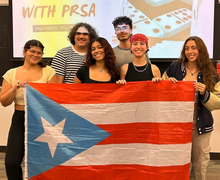In talking about ecology, art can be a more effective medium than stats, numbers
Maxine Brackbill | Photo Editor
Our columnist argues that exhibits such as Syracuse University’s “Assembly” inspire crucial conversations about climate change. The emotion and connection they spark help to spread awareness.
Get the latest Syracuse news delivered right to your inbox.
Subscribe to our newsletter here.
Whether as paintings, sculptures, photography or music, art has the potential to communicate without saying a single word. The recognition of messaging in art can introduce us to new perspectives, raise awareness of social or global issues and allow the artist to have their unique voice expressed.
Art also breaks communication barriers. For those who struggle with conventional communication due to either social anxiety, or disabilities, art offers an alternative form of self-expression. It also unites speakers of different languages – art is a universal dialect.
Through protest, art can serve as a catalyst for change. Art has been used as a protest tactic for centuries, raising awareness on social and political issues such as suffrage, war, global health issues and now more than ever – ecological issues.
Art protest has ignited awareness in the past and continues to do so increasingly as technology has provided us with yet another medium to express ourselves. Now with social media more present in our lives, there is more opportunity for artists to be recognized and for their audience to see their work. Although viewing street art from your screen seems contradictory, it allows for the art to be spread far and wide.
When Rice University Professor Timothy Morton visited the new “Assembly: Syracuse University Voices on Art and Ecology” exhibition in the Syracuse University Art Museum, he was introduced as an “academic freestyle rapper.” Until he began his presentation, I had no idea what that could possibly mean. Morton covered many ideas during his presentation, but notably, he did not use a single statistic to make his point. His book “Being Ecological,” supports this anti-fact storytelling as a means to become a good environmental samaritan.
SU Art Museum’s “Assembly” exhibition is a collection of artworks in various mediums, all made by Syracuse University faculty and recent alumni, in conjunction with works of the museum’s collection. The collection notes that ecology is a matter of intimacy; nature is not distinct from humans, rather humans are major players in the world’s ecology.
The exhibition is able to tell the story of nature, ecology and climate change in mediums other than words and numbers. The visual aspect of the exhibition is where its message is strongest. When analyzing the pieces in collaboration, the story comes to life in a way a statistical chart would be unable to.
We are consistently told the same numerical information about climate change, how much carbon dioxide is in the air, how much the temperature has risen and how much time we have left before impacts are irreversible. But how effective is it to be told the same story over and over again? In this sense, Morton’s presentation was a breath of fresh air, talking about what it means to be ecological in a philosophical sense rather than being told you must limit your carbon footprint by “X” tons.
Using mediums rather than numbers to tell stories of the environment, of nature and of climate change make the conversation more accessible to others. Climate conversation can be biased towards those unfamiliar with scientific jargon. There are barriers to understanding the conversation of climate that can be improved by changes in communication tactics, such as improved visualization.
The idea of climate change is so large and occurs at such a slow pace that recognizing the change can be difficult. Morton would refer to climate change as a “hyperobject,” or “ideas with such vast spatial dimensions that defeat the traditional ideas of what the idea is in the first place.”
Although the definition of the term in itself is hard to explain, it helps us understand that we may be able to see evidence of the hyperobject (i.e., more intense storms), but the totality is hard to be seen. We are experiencing changes that go beyond a human societal level in terms of time and parties impacted.
On Jan. 28 in Paris, two female protesters within “Riposte Alimentaire,” a climate activist group, threw soup on the “Mona Lisa” in The Louvre. The disruption was meant to begin a conversation regarding the sustainability of the agricultural system, a choice that many questioned both for its efficacy and its morality
To intentionally destroy the Mona Lisa would be nothing short of cruel, so activist groups like Riposte Alimentaire have specifically targeted paintings that are protected by a layer of glass. The reasoning behind attacking the Mona Lisa is to not destroy the art, but to disrupt the visual with another visual to portray the idea that without a habitable earth there would be no art.
The first step to taking action against the climate crisis is to talk about it. Whether that is through a typical conversation, or via a form of media bringing your attention to the topic, awareness is key. Art is unique in its ability to spread awareness as it can evoke emotions and spark human connection with the environment more effectively than a data set.
So take the time to visit the “Assembly” exhibit and experiment with different forms of media in understanding nuanced issues and ideas. There are infinite possibilities of self-expression and awareness to be brought through art, and by no means do you have to be a professional to participate. So get creative and be observant of the art that’s all around you.
Izzy Kaufman is a sophomore International Relations and Environment, Sustainability and Policy major as well as the Co-Director of the Student Association’s Sustainability Forum. Her column appears bi-weekly. She can be reached at akaufm08@syr.edu.
Published on February 29, 2024 at 1:22 am






